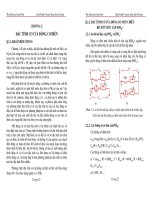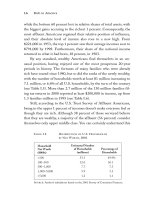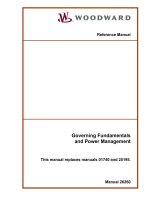Governing Fundamentals and Power Management phần 2 docx
Bạn đang xem bản rút gọn của tài liệu. Xem và tải ngay bản đầy đủ của tài liệu tại đây (442.77 KB, 10 trang )
Manual 26260 Governing Fundamentals and Power Management
Woodward 5
Chapter 2.
Hydro-mechanical Governors
Basic Hydro-mechanical Governor Components
The five fundamental components of a governor were mentioned in Chapter 1.
Now let’s take a closer look at how the basic hydro-mechanical governor works.
The key parts of a ballhead hydro-mechanical governor are:
• Speeder Spring
• Thrust Bearing
• Flyweights
• Pilot Valve Plunger
• Pilot Valve Bushing
• Oil Pumps
• Oil Pressure Regulation
• Servo (Power) Piston
• Compensation
• Drive Shaft
The Speeder Spring
The speeder spring is the part that sets the “desired speed”. Applying more force
down on the speeder spring causes the governor to increase fuel. This initial
force is usually set by the operator for the desired or “reference” speed. It can be
set by a screw adjustment, a knob, a lever, an electric motor, air pressure, or
solenoids, depending on the specific governor.
Figure 2-1. Speeder Spring
The design or shape of a speeder spring is critical to the proper operation of the
ballhead.
The speeder spring is generally shaped in a conical design. This shape helps
maintain a more rigid design so that it won’t buckle or flex to the side as force is
applied. There are other shapes of speeder springs that offer a variable force
over the length.
Some springs are designed to be close to a linear operation, and some are
designed to be non-linear depending on the specific governor. Most governors
use the linear-type speeder spring. The PG type governor uses a non-linear
speeder spring.
Governing Fundamentals and Power Management Manual 26260
6 Woodward
Thrust Bearing
The thrust bearing is the part where the force of the speeder spring and the force
of the flyweights sum together. If the speeder spring force and the flyweight force
are equal, there is no load on the thrust bearing.
Figure 2-2. Speeder Spring Deflection
A thrust bearing has a race on the top and a race on the bottom with the bearing
in between the races. Since the flyweights rotate and the speeder spring does
not rotate, the thrust bearing is necessary. The pilot-valve plunger moves with
the thrust bearing either directly or through a linkage. The pilot-valve plunger
does not rotate.
Flyweights
There are two flyweights in most ballheads. The flyweights are rotated by a drive
from the engine that is directly related to the speed of the engine.
Figure 2-3. Hydraulic Governor Ballhead
Manual 26260 Governing Fundamentals and Power Management
Woodward 7
In Figure 2-3, the flyweights are pivoted at the lower comers. As speed
increases, the flyweights move out (tip out) at the top due to the increase of
centrifugal force. This causes the “toes” of the flyweights to increase the force on
the thrust bearing and raise the pilot valve. The opposite effect happens when
speed decreases. The flyweights move in (tip in) and reduce the force on the
thrust bearing to lower the pilot valve. In Figure 2-4, the only time when the
governor is run at “desired speed setting” is when the flyweights are straight up
in the vertical position, closing the port in the pilot-valve bushing. If the flyweights
are tipped in, the engine is running below the desired speed setting and the
governor will increase fuel to increase speed until the flyweights and engine
attain the desired speed setting. If the flyweights are tipped out, the engine is
running faster than the desired speed setting and the governor will decrease fuel
until the flyweights and engine return to the desired speed setting.
Figure 2-4. Flyweight Action
Figure 2-5. Flyweights to Minimize Friction
In the most efficient flyweight design, the toes of the flyweight are offset and
contact the thrust bearing on a line at right angles to their plane of movement so
that any movement is converted into a slight rotation of the thrust bearing with a
minimum amount of sliding friction. There are other designs of flyweights.
Friction in governors is also reduced by the use of low-friction bearings. The
reduction of friction reduces the deadband between speed change and governor
output change.
Governing Fundamentals and Power Management Manual 26260
8 Woodward
Pilot Valve Plunger and Bushing
The pilot-valve plunger is positioned by the force on the thrust bearing. It moves
up and down inside the rotating pilot-valve bushing (due to the flyweights sensing
speed changes and tipping in or out). The pilot-valve bushing has high pressure
oil coming from the oil pump into the bushing above the control land of the pilot-
valve plunger.
Figure 2-6. Pilot Valve Operation Shown “On Speed”
The pilot-valve bushing has ports in it to allow the flow of oil to or from the power
cylinder assembly. When the governor and engine are at the desired speed
setting, the pilot-valve-plunger control land is centered over the port in the pilot-
valve bushing. This stops oil from flowing to or from the power cylinder assembly.
If the flyweights tip in, due to a change in speed or load, the pilot-valve plunger
moves down and let high-pressure oil into the power-cylinder assembly. This will
increase fuel.
If the flyweights tip out, due to a change in speed or load, the pilot-valve plunger
moves up to let oil drain from the power-cylinder assembly. This will decrease
fuel.
Pilot-valve-bushing ports have different sizes and shapes for different types of
governors to allow more or less oil flow, depending on the application.
The pilot-valve bushing rotates and the pilot-valve plunger does not. This
minimizes static friction (called sticktion) and allows the pilot-valve plunger to
move with very slight speed changes.
Manual 26260 Governing Fundamentals and Power Management
Woodward 9
Oil Pumps
Most hydro-mechanical governors and actuators use the governor drive to rotate
a hydraulic pump which provides the pressure oil for the system controlled by the
pilot valve. Woodward uses two different types of pumps. Most governors use
the two- or three-gear positive displacement pump. The 3161 and TG governors
and some actuators use an internal gear oil pump.
Figure 2-7. Oil Pumps
The constant-displacement pump has one drive gear and one or two idler gears
that rotate in a gear pocket. As the gears turn, oil is drawn from the oil supply
and carried in the space between the gear teeth and the walls of the gear pocket
to the discharge side of the pump. The oil is forced from the space around the
gear teeth as the drive and idler gears are rotated and becomes pressurized.
The hydraulic circuits connected to the pumps can be designed to allow either
one direction of rotation or reversible rotation for use on diesel engines with
drives that run in both directions. Check valves are used to provide pump rotation
in either direction. Plugs allow pump rotation in only one direction. Internal gear
pumps allow rotation in only one direction. The pump must be removed from the
governor and rotated 180° to change direction of rotation for internal gear pumps.
The pumps are designed to provide more pressure and flow than needed within
the governor. The extra flow of oil is returned to sump. Smaller governors use a
relief valve. Most larger governors use an accumulator system which provides a
spring-compressed reservoir of pressure oil for use during transits which
temporarily exceed the output of the pump. SG, PSG, and EGB-2 governors use
relief valves. A number of hydraulic actuators do not have accumulators.
The relief valve shown in Figure 2-8 is typical of the valves used in SG, PSG,
EGB-2 governors and many hydraulic actuators.
Internal operating oil pressures are specified for each governor. Typical
pressures are 100 to 500 psi (690 to 3448 kPa). Different types of governors
operate at different pressures. Check the specifications for your governor’s
pressure. The higher pressures are created to get more output power from the
servo controlled by the governor. Higher pressures may require the addition of
special heat exchangers to avoid damage to (break down of) the oil being used
in the governor.
Governing Fundamentals and Power Management Manual 26260
10 Woodward
Figure 2-8. Accumulator and Governor
Relief Valve
Figure 2-9. Pump Rotation
Accumulator function is shown in Figure 2-8. Pressurized oil on the discharge
side of the pump first fills the various oil passages and then forces the
accumulator pistons up against the downward force of the accumulator springs.
When the pressure increases enough to move the piston up to uncover the
bypass hole, the excess oil from the governor pump returns to sump. The
accumulators thus not only provide a reservoir for pressure oil, but also act as a
relief valve to limit maximum pressure in the hydraulic circuit. The accumulators
shown are from the power case type of governor (PG and larger EGB
governors). UG and 3161 governors use different styles of accumulators,
although the function is similar.
Direction of Rotation
The arrangement of the four check valves on the suction and discharge sides of
the oil pump permits the governor drive shaft to be rotated in either direction,
without any changes being made in or to the governor. The direction of pump
rotation does not affect the oil pressure system or governor operation.
Manual 26260 Governing Fundamentals and Power Management
Woodward 11
Some governor models are built without check valves. In these units, two plugs
replace the two closed check valves, and the governor must always be rotated in
one direction only. To change direction of rotation in these governors, the
location of the plugs must be changed by removing the base.
The internal gear pump rotates in one direction only. To change direction of
rotation in an internal gear pump, the pump is rotated 180°.
If the plugs or internal gear pump are set up for the wrong direction of pump
rotation, the governor will not have any oil pressure and cannot control the
engine. This can also cause damage to the governor. Drive rotation is always
shown looking down on the governor.
The Servo (Power) Piston
The governor pilot valve plunger controls the movement of the power piston. The
power piston, acting through the connecting linkage, controls the engine fuel.
Two types of power pistons are used in governors:
• A spring loaded system where oil pressure is used to increase the output
position. When pressure oil under the power piston is directed to sump a
return spring (either pushing directly on the piston or connected to linkage
from the piston) causes the position to move toward minimum fuel.
• A Differential Power/Servo piston uses pressure oil to move it in both
directions.
Spring-Loaded Power/Servo Piston
The governor pilot valve plunger controls the movement of the power piston. The
power piston, acting through the connecting linkage, controls the engine fuel.
Figure 2-10. Spring Loaded Servo Piston
The return spring continually pushes the power piston down in the “decrease
fuel” direction. However, the power piston will not move down unless the pilot-
valve plunger is raised above its centered position. Only when the pilot-valve
plunger is above center can the oil trapped in the circuit between the plunger and
power piston escape to sump. If the pilot valve plunger is lowered, pressure oil
from the governor pump will be directed to the power piston and will push the
piston up, against the force of the power spring, in the direction of increase fuel.
Governing Fundamentals and Power Management Manual 26260
12 Woodward
Note that the power piston will move only when the pilot-valve plunger is not
centered, permitting the oil flow required. With the plunger centered, the power
piston is, in effect, hydraulically locked.
The output of the power piston can be a push-pull motion or converted to a rotary
motion. It is designed to move the fuel to the minimum position should the oil
pressure fail.
Differential Power/Servo Piston
The governor pilot-valve plunger controls the movement of the power piston. The
power piston, acting through the connecting linkage, controls the engine fuel.
Figure 2-11. Differential Power Piston
The power piston requires pressure oil to move in either the increase or
decrease fuel direction. A differential type piston has more area on one side of
the piston than on the other. Pressure oil is constantly directed to the side with
the smaller area. This constant pressure pushes the piston in the decrease fuel
direction. The piston can only move to decrease fuel when the pilot valve is
raised above center, allowing oil to drain to sump.
If the pilot-valve plunger is below its centered position, control oil flows to the
bottom side of the power piston with the larger area. (Pressure oil is always
against the top side with the smaller area.) The pressures on both sides of the
piston are about the same, the surface area is greater on the bottom side (control
oil). This gives it a larger force and moves the piston in the increase fuel
direction.
Note that the power piston can move only when the pilot-valve plunger is
uncentered to permit the oil flow required. With the plunger centered, the power
piston is hydraulically locked.
Two different hydraulic circuits are used for the oil passages between the pilot
valve plunger control land and the power piston. The scheme used in a particular
model depends upon the size of the power piston.
The output of the power piston can be a push-pull motion or a rotary motion. Oil
stored in the governor accumulator is sufficient to move the power piston to
minimum fuel in case of governor failure.
Manual 26260 Governing Fundamentals and Power Management
Woodward 13
Chapter 3.
Droop
Introduction
Droop has many uses and applications in the control of engines. Without some
form of droop, engine-speed control would be unstable in most cases.
Droop is defined as a decrease in speed setting at the load increases.
Droop is expressed as a percentage of the original speed setting from no load to
full load. The normal recommended percent of droop is 3% to 5%. A minimum of
2.5% is required to maintain stability in a speed-droop governor.
Droop is calculated with the following formula:
% Droop =
No Load Speed – Full Load Rated Speed
Full Load Rated Sped
x 100
If, instead of a decrease in speed setting an increase takes place, the governor is
showing negative droop. Negative droop will cause instability in a governor.
Simple hydro-mechanical governors have the droop function built in and always
operate in droop. More complex governors include temporary droop, which
returns the speed setting to its original speed setting after the engine has
recovered from a change in speed or load. The temporary droop is called
“compensation.”
Why Is Droop Necessary?
In a system without droop, a load increase will cause the engine to slow down.
The governor will respond by increasing the fuel until the engine speed has
returned to the original speed.
Due to the combined properties of inertia and power lag, the engine speed will
continue to increase beyond the original speed setting, causing an overshoot in
speed. The governor again will respond to decrease speed to correct for the
overshoot. It will over-correct the speed in the other direction causing an
undershoot. This overcorrection of speed in both directions (instability) will
amplify until the engine trips out on overspeed.
Figure 3-1. Response Curves of Governor without Droop or Compensation
Governing Fundamentals and Power Management Manual 26260
14 Woodward
This instability problem can be eliminated with droop. As the load increases, the
speed setting is decreased. When the governor moves to correct for the speed
decrease caused by the increased load, it will be correcting to a lower speed
setting. This lower speed setting prevents the speed from overshooting.
Speed Droop Operation
Simple Speed Droop Governor
Figure 3-2. Droop Feedback
As load is applied to the engine, the power piston moves up to increase fuel. The
droop feedback lever is connected to the power piston and speeder spring. The
feedback lever pulls up on the speeder spring to reduce its force. With less force
on the speeder spring, the speed setting is decreased, causing the droop action
which maintains the load at a lower speed.
Compensated Governors
For compensated governors, when a load is applied, the temporary force of the
compensation system pushes up on the pilot valve compensation land. This
force adds to the force of the flyweights to close the pilot valve before the engine
speed is reached. This temporary force addition works in the same way as if the
speed setting had been reduced. The force through the needle valve of the
compensation system is reduced to zero as the engine returns to speed. This is
known as “temporary droop”.









